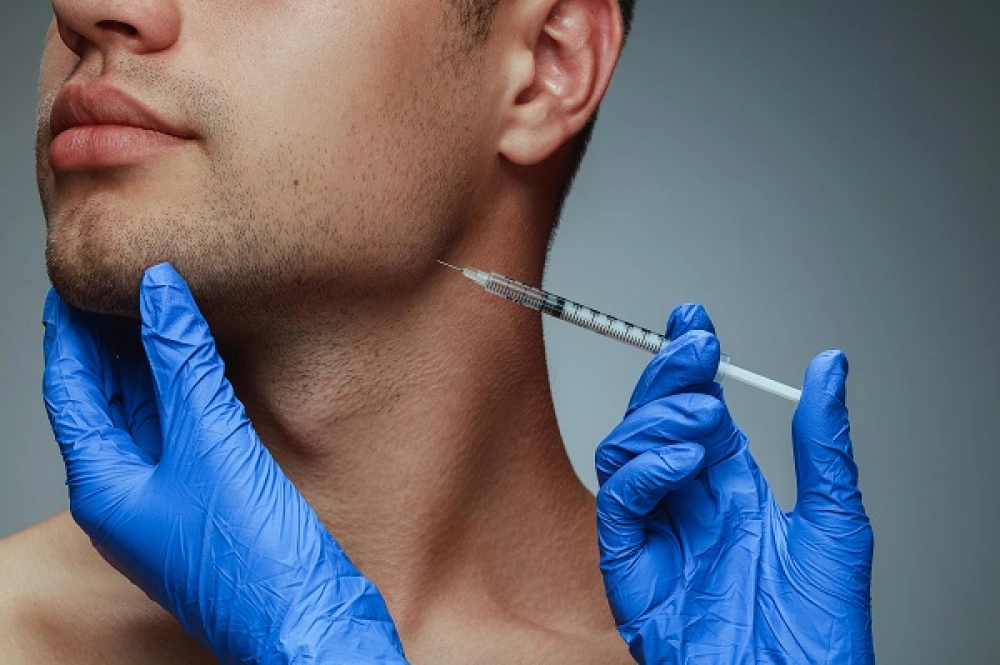
Biostimulators
Many patients desire to improve skin texture and address wrinkles and sagging. Apart from surgical procedures or laser treatments, there are also substances that are injected into the skin to achieve these goals. What makes these substances special? What can they do? Is this right for you? Find more detailed information here.
Photo: © master1305 – stock.adobe.com
-
What are Biostimulators?
-
How do such substances work?
-
What is the difference between the Biostimulators "Poly-L-lactic acid" and "Calcium hydroxylapatite"?
-
How safe are Biostimulators?
-
What is the difference compared to Hyaluronic Acid?
-
What does the treatment look like?
-
Which indications are commonly treated with Biostimulators?
-
What downtime should I expect?
-
Which treatments are commonly combined with Biostimulators?
-
Which areas can be treated?
-
When will I see results? How many treatments are necessary?
-
Is this treatment suitable for me?
-
What are the costs involved?
-
Which doctors at 'Medizin am Hauptbahnhof' have the most experience?
What are Biostimulators?
Biostimulators encompass a range of substances used in medicine to stimulate the body's natural healing processes, promoting cell renewal and rejuvenation of tissues. These substances can include PRP (Platelet-Rich Plasma) derived from platelets or industrially produced substances like Polylactic acid and Calcium Hydroxylapatite. Exosomes, newly discovered small vesicles released by cells, are also part of this category, capable of transmitting essential information between cells and stimulating cellular rejuvenation.
How do these substances work?
All these substances share the common goal of promoting the body's healing and renewing the target tissue. Polylactic acid, for instance, strongly stimulates subcutaneous fat tissue, commonly used for patients with a "hollowed" appearance (e.g., in temples or cheekbones). Calcium Hydroxylapatite is often used for tissue building, scar treatment, and tightening. Platelets in our blood contain messenger molecules that can be specifically delivered into the target tissue through PRP treatment.
What is the difference between the Biostimulators "Poly-L-lactic acid" and "Calciumhydroxylapatite"?
Both Poly-L-lactic acid and Calcium Hydroxylapatite are materials used in aesthetic dermatology as fillers for treating wrinkles and volumizing. Despite some similarities, there are significant differences between the two substances. The main difference lies in their composition. Poly-L-lactic acid is a biodegradable polymer (chain) made up of lactic acid molecules. Calcium Hydroxylapatite is an inorganic material present in the form of tiny microspheres composed of calcium and phosphate ions, similar to the minerals found in bones.
The second difference lies in their duration of action, both generally being slower to degrade than Hyaluronic Acid. Poly-L-lactic acid's duration can vary, but it tends to last longer than many other fillers because it can stimulate collagen production long-term. It gradually breaks down and is absorbed by the body, supporting natural collagen regeneration over a period of 24 to 36 months after application. We recommend 2 treatment sessions.
Calcium Hydroxylapatite generally lasts longer than Hyaluronic Acid but shorter than Poly-L-lactic acid, typically being absorbed after about 1.5 years. Since there are no specific enzymes in the human body for its degradation, as with Hyaluronic Acid, the results last slightly longer.
The last difference lies in their different areas of application. Poly-L-lactic acid is often used to treat areas with significant volume loss, such as temples or cheeks, as well as sagging in the knee area or buttocks, or volume loss after significant weight reduction, as well as atrophic (acne) scars, resulting in tighter skin and overall improvement in skin quality. Calcium Hydroxylapatite is often used to treat deeper wrinkles and volumize larger areas of the face like the cheeks, to fill marionette lines, but also highly diluted in the neck, décolleté, or back of the hands. We usually recomend two ampulles per session to get good results.
Ultimately, the choice between Poly-L-lactic acid and Calcium Hydroxylapatite, as well as their specific application, depend on the results the patient wishes to achieve, how long they want to maintain the results, and which areas of the face need treatment. Thorough consultation with one of our dermatologists at our center at Vienna Main Station ensures that you receive the best option for your individual needs.
How safe are Biostimulators?
Biostimulators are considered safe in dermatology when applied by qualified and experienced professionals. The safety of these substances is based on several factors. Biostimulators are biocompatible, meaning they interact well with body tissues and rarely trigger allergic reactions/autoimmune reactions. Furthermore, biostimulators are gradually broken down and absorbed by the body over time, usually leaving no permanent residues in the tissues. With years of application experience and having been used in aesthetic dermatology for several decades, they have proven to be safe and effective in clinical studies and practice. Calcium Hydroxylapatite was officially approved in the EU in 2004, and Poly-L-lactic acid in the United States, also in 2004.
What is the difference compared to Hyaluronic Acid?
Hyaluronic Acid is commonly used to fill in areas of volume loss in the cheeks, lips, or other facial areas over time. A small implant is placed, which is gradually absorbed. In contrast, Biostimulators are injected, and while there may be little immediate effect, over the next few months, there is a stimulation of the body's own tissues, especially fibroblasts. The subcutaneous layers become thicker through this process, the skin overall becomes tighter, and there is often an improved and more even pigmentation. It truly turns back the clock.
In addition to the previously mentioned biostimulants, there is also highly concentrated non-crosslinked hyaluronic acid that can be injected into the deeper layers of the skin to stimulate collagen production. This treatment is very popular because, in addition to its biostimulatory effects, it also replenishes the skin with moisture, delivering very natural results. Typically, two treatments are required at intervals of 3–4 weeks. Only five specific points on each side of the face are injected, and the hyaluronic acid then disperses over the following days.
What does the treatment look like?
During treatment, the active ingredients are placed in the correct skin layer through injections to achieve optimal results. We prefer using a minimally invasive technique with cannulas to apply the active ingredients, which generally reduces downtime.
Which indications are commonly treated with Biostimulators?
In addition to the classic facial treatment for tightening and optimization, there is also an option for challenging-to-treat areas such as the neck, décolleté, and hands. Some scars are also significantly improved with Biostimulators.
What downtime and side effects should I expect?
After treatment, there may be slight swelling, which usually subsides within a few hours to days. Occasionally, bruising may occur at the injection sites, which disappears after a few days. Very rarely, there may be intolerance reactions, nodules, or infections.
Which treatments are commonly combined with Biostimulators?
We can further optimize the results by combining them with other treatments, such as laser treatments or other wrinkle injections. It is important that we take time to create a treatment plan tailored to your needs and budget. Every patient is different, and so is their treatment plan. Part of the treatment plan also includes optimal care and sun protection after treatment. Find out more about combination treatments here - Faltenfrei.
Which areas can be treated?
The area that we can treat well with the products is primarily the lower half of the face (cheeks, chin). However, the forehead, eyelids, and lips are less suitable. In some patients, the neck, décolleté, and hands can also be treated.
When will I see results? How many treatments are necessary?
Due to the way they work, it can take up to 3 months for the final results to fully manifest. Depending on the initial condition, a second session may be done after about 3 months. Many patients opt for maintenance treatment after 1-2 years. These are rough guidelines, and our doctors will advise you individually.
Is this treatment suitable for me?
The treatment is optimal for patients who want tightening, a fresher appearance, but still want to look natural. Especially older patients and men are very satisfied with the treatment. It's important to note that the effects take time to appear but are more natural and longer-lasting. Do you want even more information? Please check in here.
What are the costs involved?
The treatment concept will be discussed individually with you; you can expect costs ranging from EUR 450 to EUR 850 for a single treatment.
Which doctors at 'Medizin am Hauptbahnhof' have the most experience?
Select the appointment type "11. Wrinkle treatment consultation" and experienced colleagues Dr. Bisschoff, Dr. Kapsch, Dr. Maggoschitz, Dr. Spiegelfeld, and Prof. Dr. Rzany


